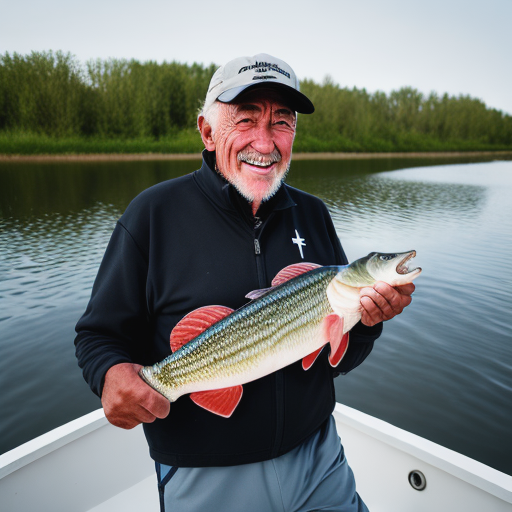To effectively enhance your fishing effectiveness and protect your line, it is important to master the techniques for adjusting the drag on your fly reel. By understanding how to set the drag and make necessary adjustments, you can prevent line breakage and improve your chances of landing fish.
Key Takeaways:
- Mastering the techniques for adjusting the drag on your fly reel is essential for effective fishing.
- Setting the drag on a fishing reel before your first cast is important as adjusting it while fighting a fish can be difficult.
- Different types of reels, such as spinning reels and baitcaster reels, require specific drag adjustment techniques.
- Factors such as target species, fishing conditions, and personal preference should be considered when adjusting the drag.
- Regular maintenance of your fly reel is crucial to ensure optimal performance and prolong its lifespan.
Understanding Fly Reel Drag Systems
The drag system in a fly reel is a crucial component that helps control the resistance on the fishing line. It consists of friction plates that play a key role in maintaining the tension during a fish fight. Understanding how the drag system works is essential for anglers looking to maximize their chances of landing fish.
When a fish pulls on the line with enough force, the resistance created by the friction plates is overcome. This allows the reel to rotate backward, effectively letting the line out. The tension of the drag system is carefully calibrated to strike a balance between preventing line breakage and allowing the line to be released incrementally.
Setting the drag on a fishing reel before your first cast is a critical step. It ensures that the desired amount of resistance is applied when a fish takes the bait. Adjusting the drag while fighting a fish can be challenging and may result in lost fish or broken lines. By setting the drag system correctly from the start, you can increase your chances of success on the water.
To provide a better understanding of the drag system, here is an illustration:
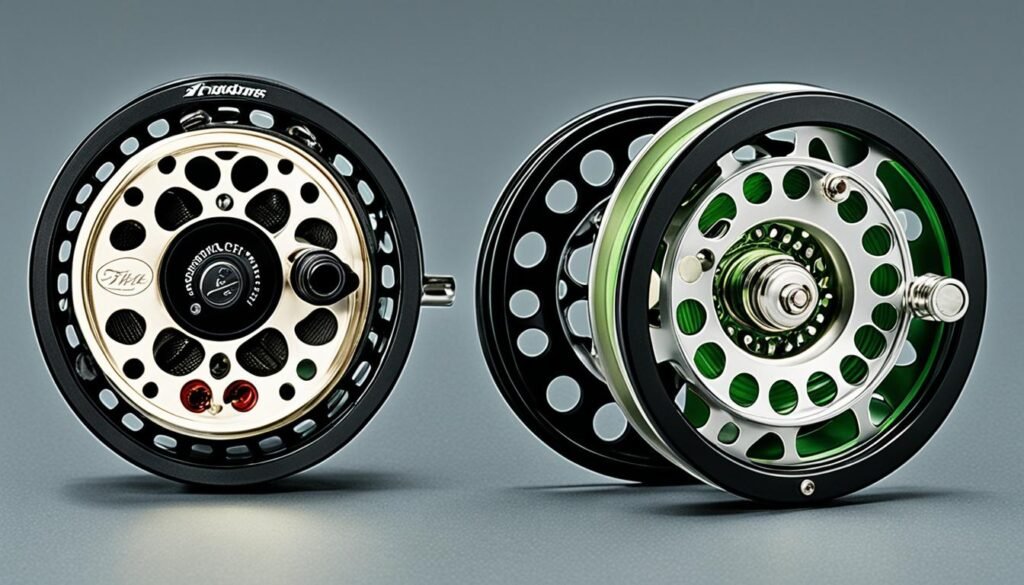
| Component | Description |
|---|---|
| Friction Plates | These plates create the necessary resistance when a fish pulls on the line. They allow the line to be released gradually, preventing sudden breakage. |
| Drag Adjustment Knob | Located on the fly reel, this knob allows anglers to adjust the tension of the drag system. Turning it clockwise tightens the drag, while turning counterclockwise loosens it. |
| Drag Scale | Some fly reels feature a visual scale that indicates the amount of drag applied. This helps anglers make precise adjustments based on their preferences and fishing conditions. |
Understanding how the drag system operates and mastering its adjustment techniques can greatly enhance your fishing experience. With a well-calibrated drag system, you’ll be better equipped to handle powerful fish and reduce the risk of line breakage.
How to Set Drag on Spinning Reels
Setting the drag on a spinning reel is a crucial step to ensure a successful fishing experience. By properly adjusting the drag, you can prevent line breakage and increase your chances of landing fish. Here’s a step-by-step guide on how to set the drag on a spinning reel:
- Locate the front drag adjustment button on your spinning reel. This button is usually situated on the front of the reel, near the spool.
- Turn the front drag adjustment button clockwise to increase the drag tension or counterclockwise to decrease it. Make adjustments in small increments to find the ideal setting.
- To determine the appropriate drag setting, you can perform a simple test. Pull on the line above the reel with your hand or use a small spring scale to measure the tension.
-
“It is recommended to have the drag set loose enough to prevent line breakage but tight enough to hold the weight of the line.”
Having the drag properly set on your spinning reel ensures that it will release line smoothly when a fish pulls, minimizing the risk of breakage. Striking the right balance between a loose and tight drag is crucial to maintain control over the fish and prevent it from snapping the line. Take the time to adjust and test your spinning reel drag before you cast.
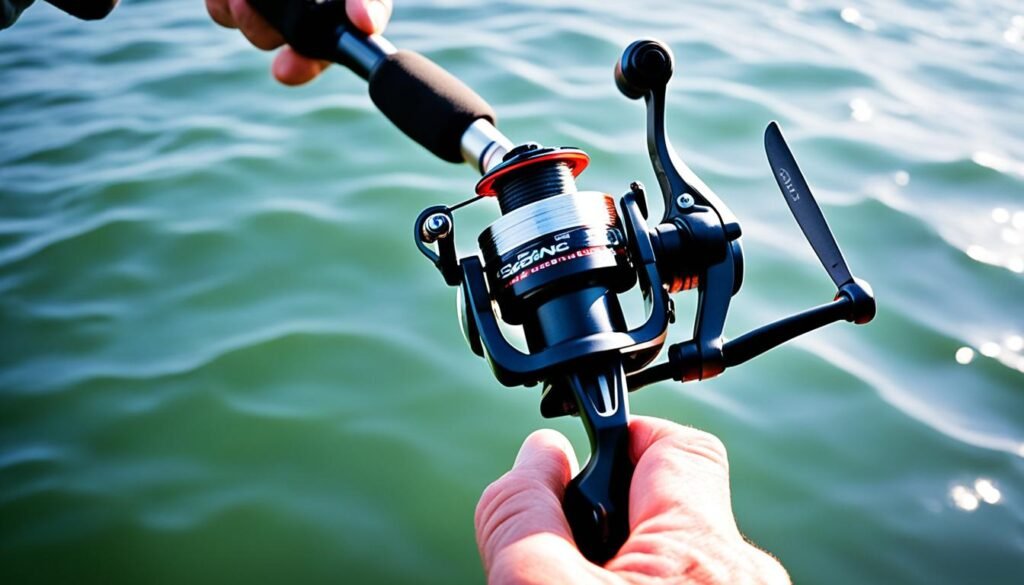
| Advantages of Proper Drag Adjustment on Spinning Reels |
|---|
| Prevents line breakage |
| Increases landing success |
| Provides better control over hooked fish |
| Reduces the risk of losing fish due to line snaps |
How to Set Drag on Baitcaster Reels
Setting the drag on a baitcaster reel is essential for controlling the amount of resistance when a fish pulls on the line. Baitcaster reels feature a star-shaped drag mechanism located next to the reel, which allows for precise drag adjustments. Follow these steps to properly set the drag on your baitcaster reel:
- Tighten or loosen: To adjust the drag, turn the star-shaped mechanism to the right to tighten or to the left to loosen it. This simple action increases or decreases the amount of resistance applied to the fishing line.
- Gradual adjustments: Start with a moderate drag setting and make gradual adjustments to find the right balance. It’s important to avoid sudden changes in the drag to prevent line breakage during intense fish fights.
- Braided line precautions: When using braided fishing line, it’s crucial to take extra precautions. Wrapping the line around a small handle or pencil while adjusting the drag can prevent injury caused by the line slipping through your bare hands.
When properly set, the drag on a baitcaster reel allows for smooth line release when a fish strikes, reducing the risk of line breakage. Additionally, it provides the angler with better control and helps tire out the fish more effectively during the fight.
Fishing Pro Tip:
Remember, adjusting the drag according to the size and strength of the fish you’re targeting is key to a successful catch. Be mindful of your drag settings to prevent any chances of losing the battle.
So, always keep your baitcaster reel’s drag at the optimal setting to make the most out of your fishing experience.
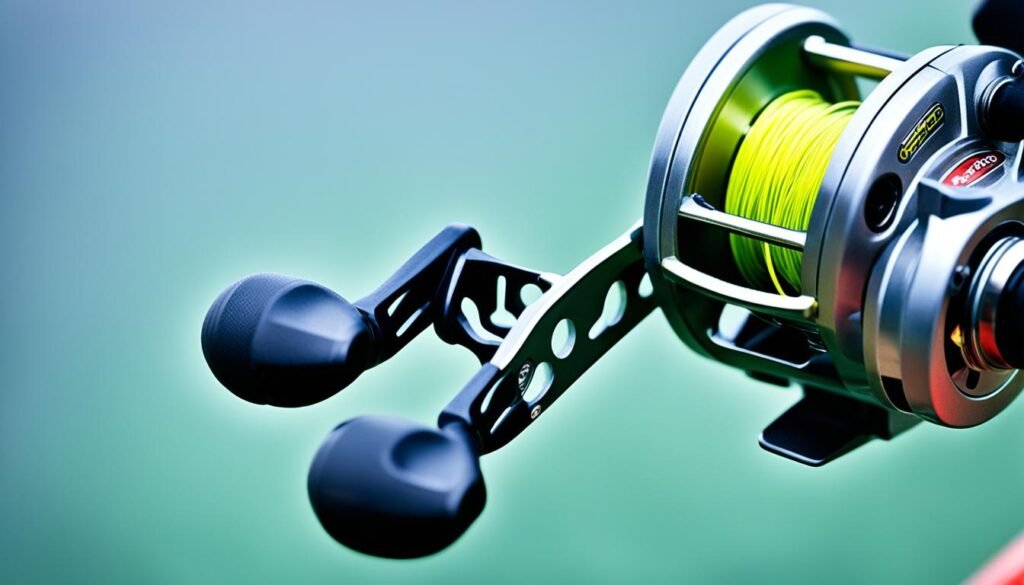
Factors to Consider When Adjusting the Drag
When adjusting the drag on a fly reel, there are several important factors to consider. These factors will help you find the right balance between preventing line breakage and allowing some line to be pulled out when a fish bites. By taking these factors into account, you can optimize your drag settings for a successful fishing experience.
- Target Species: Different fish species have different characteristics and behaviors. Consider the size, strength, and fighting style of your target species when setting the drag. Larger, more powerful fish may require a tighter drag setting to prevent them from breaking the line, while smaller or more delicate species may require a looser drag to avoid pulling the hook.
- Fishing Conditions: The fishing conditions also play a role in determining the appropriate drag setting. In windy conditions or fast-moving currents, you may need a tighter drag to maintain control over the fish. On the other hand, in calm and clear water, a looser drag may be sufficient.
- Personal Preference: Every angler has their own preference when it comes to drag settings. Some prefer a tighter drag to quickly tire out the fish and bring it in, while others prefer a looser drag to give the fish more leeway and prolong the fight. Experimentation and experience will help you find the drag setting that works best for you.
Remember, it’s better to err on the side of caution and have the drag slightly looser than too tight. Fighting a fish a little longer is preferable to the risk of breaking off a big catch due to excessive drag. As you gain experience and learn more about different fish species and fishing conditions, you can refine your drag settings for optimal performance.

“Finding the right drag setting is a delicate balance between control and flexibility. Understanding the factors at play and fine-tuning your drag adjustments will give you the confidence to tackle any fish that comes your way.”
Different Drag Adjustment Techniques
Adjusting the drag on fly reels can be done using various techniques. Anglers may choose to adjust the drag based on feel or utilize specific measurements and tests to determine the appropriate setting. Finding the technique that suits you best and allows for easy adjustment while fishing is crucial for optimal performance.
Some anglers rely on their intuition and experience to adjust the drag by feel. They assess the tension and resistance while reeling in a fish and make adjustments accordingly. This method requires a good understanding of the target species and their fighting characteristics, as well as practice and finesse.
Other anglers prefer a more precise approach, using specific measurements or tests. One popular technique is the “line pull” test, where an angler attaches a spring scale to their line and pulls it to determine the drag tension. This method provides a numerical value that can be adjusted based on the angler’s preferences and fishing conditions.
Using the line pull test gives me a reliable measurement of the drag tension. It takes away the guesswork and allows me to have consistent settings for different fishing situations.” – David Smith, experienced fly angler
Another technique involves adjusting the drag based on the fish’s weight or size. Anglers may use a chart or reference guide that suggests the appropriate drag setting for different fish species based on their average weight. This method provides a starting point for setting the drag and can be adjusted further depending on the specific circumstances.
Ultimately, the key to successful drag adjustment is finding the technique that works best for you. Whether it’s relying on your instincts and experience or using specific measurements and tests, the goal is to have a drag setting that prevents line breakage while allowing for controlled line release when a fish bites.
Drag Adjustment Techniques Comparison
| Technique | Advantages | Disadvantages |
|---|---|---|
| Adjusting by Feel | Relies on angler’s intuition and experience | Requires practice and finesse |
| Line Pull Test | Provides precise numerical values | May not account for all fishing conditions |
| Weight-based Adjustment | Provides a starting point based on fish size | Varies depending on fish species |
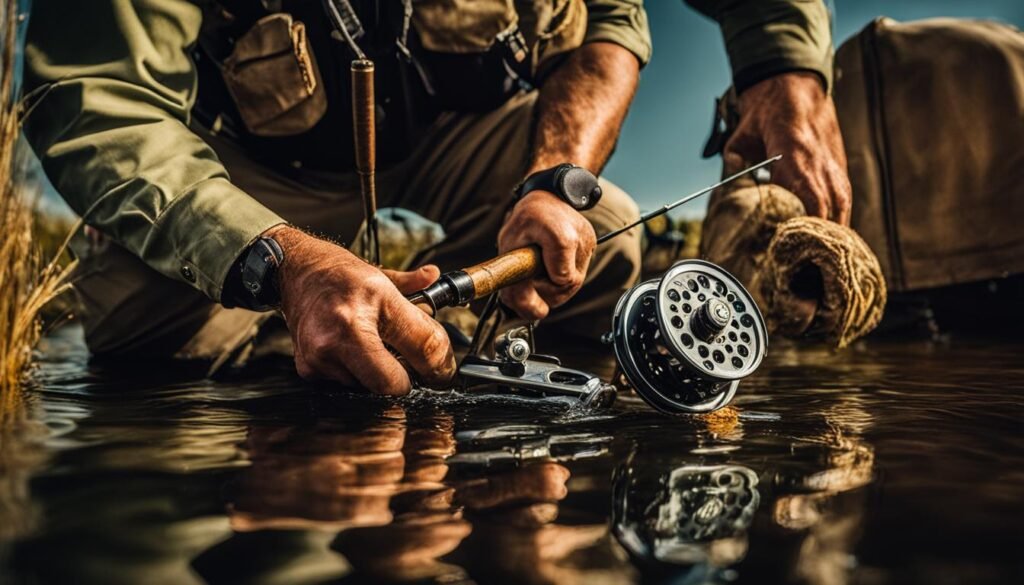
Remember, adjusting the drag on your fly reel is a personal preference, and it may vary depending on the fishing situation. It’s essential to experiment with different techniques and find what works best for you. With practice and experience, you will become adept at setting the drag to maximize your chances of landing fish while preventing line breakage.
Importance of Regular Maintenance
Regular maintenance is an essential aspect of ensuring that your fly reel’s drag system operates smoothly and efficiently. By taking the time to clean, lubricate, and inspect your reel, you can extend its lifespan and maximize its performance on the water.
Proper maintenance of your fly reel’s drag system involves several key steps:
- Cleaning: Remove any dirt, debris, or residue from the drag system using a soft cloth or brush. This helps prevent friction and ensures smooth operation.
- Lubrication: Apply a small amount of reel oil or lubricant to the moving parts of the drag system. This reduces friction and allows the drag to function more efficiently.
- Inspection: Regularly check the drag system for any signs of damage, wear, or corrosion. This includes examining the drag washers, drag knob, and drag adjustment mechanism. If you notice any issues, it’s important to address them promptly to prevent further damage.
- Replacement: Over time, drag washers may become worn and lose their effectiveness. If you notice a significant decrease in drag performance, consider replacing the washers or any other worn parts to maintain optimal drag settings.
By following these maintenance practices, you can keep your fly reel’s drag system in excellent condition and ensure that it operates smoothly when you’re engaged in your favorite angling pursuits.
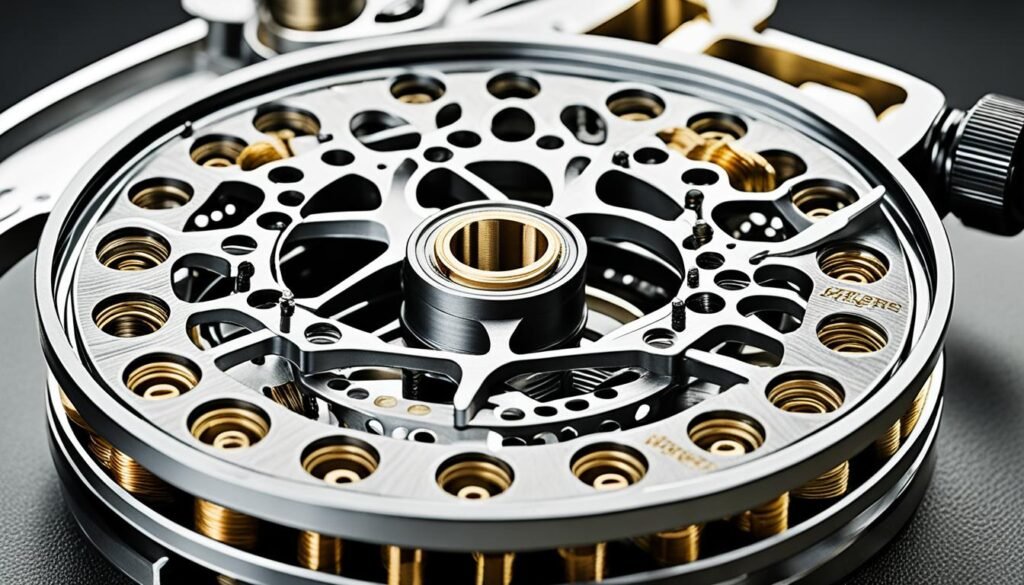
The Benefits of Low Startup Inertia Drag
When it comes to fly reels, one important feature to consider is the low startup inertia drag. This type of drag system is designed to provide a smooth and consistent resistance, regardless of the speed at which the fish is swimming. It offers several benefits that can greatly enhance your fishing experience.
First and foremost, the low startup inertia drag allows for better control when fighting fast or powerful fish. It ensures that the resistance remains constant, allowing you to maintain a steady pressure on the line without sudden jerks or surges. This stability can significantly reduce the risk of line breakage, ensuring that you have a better chance of landing your prized catch.
Additionally, the low startup inertia drag offers a more seamless transition from no drag to a controlled resistance. This means that even when a fish takes a sudden and aggressive bite, the drag system responds quickly and smoothly, absorbing the initial shock without snapping the line. This quick response time allows you to react swiftly and maintain control over the fish.
Choosing a fly reel with a low startup inertia drag can make a world of difference in your fishing success. It combines the advantages of a smooth and consistent resistance with the ability to handle fast and powerful fish. Whether you’re targeting speedy trout or battling with formidable saltwater species, this drag system can provide you with the control and protection you need.
Benefits of Low Startup Inertia Drag:
- Improved control over fast or powerful fish
- Reduced risk of line breakage
- Smooth and seamless drag response
- Enhanced ability to handle sudden and aggressive bites
- Increased chances of landing prized catches
Investing in a fly reel with a low startup inertia drag is a smart choice for any angler looking to take their fishing prowess to the next level. The combination of control, responsiveness, and line protection makes it an essential feature for tackling challenging fishing situations.
| Reel Brand | Model | Drag Type | Low Startup Inertia |
|---|---|---|---|
| Brand A | Model X123 | Disc Drag | No |
| Brand B | Model Y456 | Click and Pawl | Yes |
| Brand C | Model Z789 | Hybrid Drag | Yes |
As you can see, not all fly reels offer the low startup inertia drag. When selecting a reel, be sure to check the specifications to ensure that it has this beneficial feature. By investing in a reel with a low startup inertia drag, you’ll have peace of mind knowing that you have a tool specifically designed to handle the demands of powerful fish and increase your chances of a successful catch.
Perfecting Your Drag Settings
When it comes to fly fishing, perfecting your drag settings is crucial for a successful and enjoyable fishing experience. Adjusting the drag on your fly reel allows you to control the amount of resistance applied to the fishing line when a fish bites, preventing line breakage and helping you land your catch.
Perfecting your drag settings is a personal process that involves experimentation and understanding of the fish species you’re targeting and the fishing conditions you’re facing. By starting with a conservative drag setting and making adjustments based on the behavior of the fish and your fishing experience, you can fine-tune your drag settings to achieve optimal results.
Practice and observation are key in finding the optimal drag settings for different fishing situations. Take the time to experiment with different drag settings and see how they affect your casting and hooking success. Pay close attention to the behavior of the fish and make adjustments accordingly.
Remember, it’s always better to have the drag too loose and fight a fish a little longer than to have it too tight and risk breaking off a big catch. By finding the perfect balance between line tension and fish fighting ability, you can increase your chances of landing that trophy fish.
If you’re relatively new to fly fishing, don’t be discouraged if it takes some time to find the right drag settings. With practice and patience, you’ll develop a better understanding of when to adjust your drag and how to fine-tune it for different fishing scenarios.
So get out on the water, experiment with your drag settings, and enjoy the thrill of hooking and landing fish with confidence!
Tips for Perfecting Your Drag Settings:
- Start with a conservative drag setting and make gradual adjustments.
- Pay attention to the behavior of the fish and adjust the drag accordingly.
- Practice different casting and retrieving techniques to understand how drag affects your line.
- Take notes of your drag settings and fish-catching success to track your progress.
- Consult with experienced anglers or fishing guides for additional tips and advice.

Examples of Drag Settings for Different Fish Species
| Fish Species | Drag Setting |
|---|---|
| Trout | Light to moderate drag setting |
| Bass | Moderate to heavy drag setting |
| Salmon | Heavy drag setting |
| Tarpon | Very heavy drag setting |
Tips for Effective Drag Adjustment
Mastering the skill of adjusting the drag on your fly reel is crucial for a successful fishing experience. To help you fine-tune your drag control, here are some valuable tips:
-
Start with a conservative drag setting and make gradual adjustments.
When setting your drag initially, it’s wise to err on the side of caution. Begin with a lower drag setting and gradually increase it as needed. This approach allows you to maintain control over the reel and prevents sudden line breaks when a fish strikes.
-
Pay attention to the behavior of the fish and adjust the drag accordingly.
Observe how a fish is fighting and adjust your drag in response. If the fish is making powerful runs, consider loosening the drag slightly to provide some give. Conversely, if the fish is making quick and erratic movements, tightening the drag can help you maintain control.
-
Use a small spring scale or other fish handling devices to test the drag tension.
For precise drag adjustment, you can use a small spring scale or any fish handling device that allows you to measure the tension. This will help you find the optimal setting and ensure that your drag is neither too loose nor too tight.
-
Regularly maintain and lubricate your fly reel to ensure optimal drag performance.
Proper maintenance is essential for keeping your fly reel’s drag system in top shape. Regularly clean and lubricate the reel to prevent any friction issues that could affect the smoothness of the drag. Doing so will help preserve the performance and longevity of your reel.
-
Experiment with different drag adjustment techniques to find what works best for you.
Every angler has different preferences when it comes to adjusting the drag. Feel free to experiment with various techniques and find what suits you best. Whether it’s using specific measurements or relying on your instinct and feel, the key is to discover the method that gives you the most control and confidence while fishing.

Conclusion
Mastering the techniques for adjusting the drag on your fly reel is essential for effective fishing. By understanding the drag system and learning how to set the drag on different types of reels, you can optimize your fishing experience. Remember to consider important factors such as the target species and fishing conditions when adjusting the drag.
Regular maintenance is also crucial to ensure the drag system functions properly. Cleaning, lubricating, and inspecting the drag system regularly will prolong the lifespan of your fly reel and ensure optimal performance. Additionally, experimenting with different drag adjustment techniques will help you find the settings that work best for you.
Always be mindful of the drag tension and make adjustments as needed to prevent line breakage and maximize your chances of landing fish. With these fly reel drag adjustment techniques, you can enhance your fishing effectiveness and enjoy the thrill of reeling in your prized catch. Happy fishing!
FAQ
What is the purpose of adjusting the drag on a fly reel?
Adjusting the drag on a fly reel enhances fishing effectiveness and protects the fishing line by preventing line breakage and improving the chances of landing fish.
How does the drag system in a fly reel work?
The drag system in a fly reel consists of friction plates that control the resistance on the fishing line. When a fish pulls on the line with enough force, the friction is overcome and the reel rotates backward, letting the line out.
How do I set the drag on a spinning reel?
To set the drag on a spinning reel, turn the front drag adjustment button to tighten or loosen the tension. Test the drag by pulling on the line above the reel with your hand or using a small spring scale to determine the appropriate setting.
How do I set the drag on a baitcaster reel?
To set the drag on a baitcaster reel, turn the star-shaped drag mechanism located next to the reel. Turn it to the right to tighten and to the left to loosen it. When using braided fishing line, avoid using bare hands and instead test the line by wrapping it around a handle or pencil.
What factors should I consider when adjusting the drag on a fly reel?
When adjusting the drag on a fly reel, consider factors such as the target species, fishing conditions, and personal preference. The drag should be set tight enough to prevent line breakage but loose enough to allow some line to be pulled out when a fish bites.
What are some different techniques for adjusting the drag on fly reels?
There are various techniques for adjusting the drag on fly reels. Some anglers prefer to adjust the drag by feel, while others use specific measurements or tests to determine the appropriate setting. Find the technique that works best for you and allows for easy adjustment while fishing.
How important is regular maintenance for the fly reel’s drag system?
Regular maintenance of your fly reel is crucial to ensure its drag system functions properly. This includes cleaning and lubricating the drag system, checking for any damage or wear, and replacing any worn parts. Maintaining your fly reel prolongs its lifespan and ensures optimal performance on the water.
What are the benefits of a low startup inertia drag in a fly reel?
A low startup inertia drag provides a smooth and consistent drag resistance at all fish-driven speeds. This type of drag system is particularly useful when fighting fast or powerful fish, as it allows for better control and reduces the risk of line breakage.
How can I perfect my drag settings on a fly reel?
The process of perfecting drag settings involves experimentation and understanding of the fish species and fishing conditions. Start with a conservative drag setting and make adjustments based on the behavior of the fish and your fishing experience. Practice and observation will help you find the optimal drag settings for different fishing situations.
What are some tips for effective drag adjustment on a fly reel?
Some tips for effective drag adjustment include starting with a conservative drag setting and making gradual adjustments, paying attention to the behavior of the fish and adjusting the drag accordingly, testing the drag tension with a small spring scale or other fish handling devices, regularly maintaining and lubricating your fly reel, and experimenting with different drag adjustment techniques to find what works best for you.

